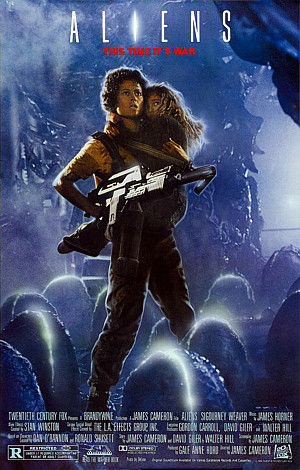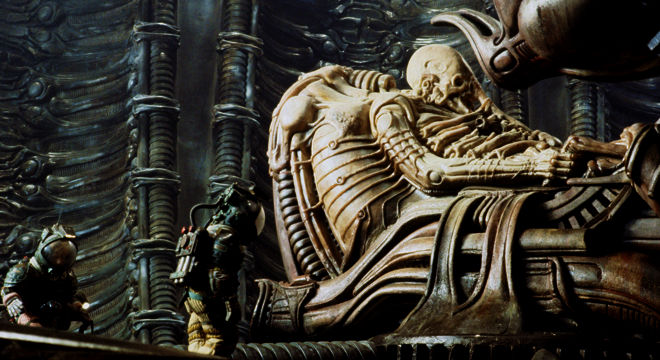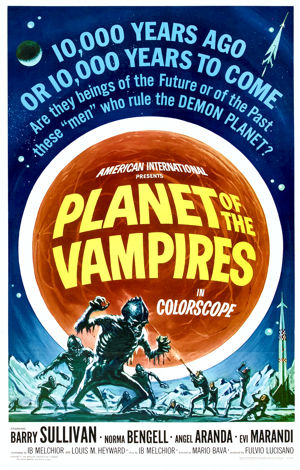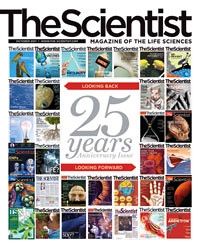 |
 |
SCIENCE MOMENTS by Kelly Parks & E.C.McMullen Jr. |
 |
||

ALIEN: !!!SCIENCE MOMENT!!!20th Century FoxRatings: USA: R |
|||||
ALIEN SCIENCE MOMENT
 SCIENCE MOMENT by SCIENCE MOMENT byKELLY PARKS |
ALIEN
Every form of life on Earth, from bacteria to oak trees to people, is based on DNA. But DNA is far from the only solution to the chemistry problem of self-replicating molecules1. Life that evolved elsewhere would certainly be based on different chemistry.
What I'm getting at is the idea that a creature like this could have naturally evolved the ability to make use of alien biochemistry is out of the question.
I'm not saying these monsters are impossible – I'm saying they can only be artificial. They were created by a culture with a very advanced understanding of extraterrestrial biology and genetic engineering.
1
 SCIENCE MOMENT by E.C. McMULLEN JR. |
But since we have no contrary evidence, DNA may be the only solution to the chemistry problem of self-replicating molecules that create life as we know it. Having only one planet in our solar system that has the only type of life form we can recognize, has its drawbacks.
Before the alien creature is shown respirating in our atmosphere (aboard the Nostromo - Nitrogen, Oxygen) and requiring plenty of water (Oxygen, Hydrogen), we see it did damage to another xenomorph (the alien pilot).
H. R. Giger's "Pilot" has a head, neck, and endoskeleton, so it's a vertebrate creature. From its four limbs of two matching arms connected to shoulders, a pelvic center, and two matching legs, to its bipedal upright chest structure and multiple ribs joined at the center of the cage, to its two matching enclosed orbital eye sockets and lower mandible, the dead alien pilot is a remarkably familar bilaterally symmetrical anthropodal humanoid being.

Moreover, screenwriter Dan O'Bannon, who also supplied the science dialog, has Ash speak of the facehugger's complex cell structure, so the alien is not a Prokaryote ("I have confirmed that he's got an outer layer of protein polysaccharides." - A component of human blood serum). The facehugger is also a bilateral symmetrical vertebrate creature as well, as is the alien baby, as is the full grown alien. To our current knowledge, only 22 amino acids can exist in a Eukaryote creature. Since the aliens were capable of feeding off of the dead pilot as well as us, the suggestion in this movie is that, while life may be prevalent in the universe, DNA (carbon-based) is a common solution for multicellular, complex, oxygen breathing humanoid life forms.
ALIEN NEWSYou like the Science in your Science Fiction? Check out our article, |
In our part of the galaxy anyway.
DNA would not be unusual for life forms that come from yellow-dwarf main-sequence stars like our own. The same common elements in our star, Sol, are the same common elements found on earth, and so us.
That is also not unusual because our type of sun is a common type. The accretion disk material that creates our sun generally creates the planets in its orbit, excepting large bodies that may become trapped into orbit around our sun (like, possibly, Pluto).
But even such exo-bodies would be immersed in that accretion disc, eventually being covered in an ablative or crust, not unlike the earth's largely oxygen and silicon crust, and so only forming life made from that crust and the sun's light and matter hitting earth.
So given enough solar systems (as many as 100 billion in our galaxy alone. 19 nearby Sol type suns with solar systems - and counting - just within our tiny neighborhood of the galactic arm); With enough planets; Within the right distance; Orbiting a star like ours; With enough gravity to hold a dense enough atmosphere; Will have reducing gases like nitrogen, methane, ammonia, and also carbon dioxide. A chemical mix courtesy of the Sol type star.
Does a Sol type sun (G-type main-sequence star - G2V) have to produce carbon-based amino acid life forms?
We aren't sure. All research points in that direction so... Maybe.
In 1953 at the University of Chicago, Stanley L. Miller and Harold C. Urey, using heat and electricity to represent volcanic activity and storms, and the primordial gases of methane, ammonia, hydrogen, and water, showed what would happen to such gases on a young planet.
Yet their experiment is not the only solution to creating amino acids.
Leslie E. Orgel, while at CalTech, took what could be considered the opposite approach and tried freezing various primordial compounds and elements, to imitate earth during an ice age. When he froze hydrogen cyanide and ammonia in H2O, it made adenine, one of the four bases of our DNA (Adenine, Thymine, Guanine, Cytosine - ATGC). The spiral strands of DNA could have been formed by either tropical environment, freezing environments, or a combination of the two (imagine amino acid-laced primordial ice bergs drifting into tropical climes.). The point is, in an earth-type environment, which is created by a Sol type, G2V star, DNA may be the only possible choice.
If that's the case, and there is no evidence to prove or disprove it, the alien is a natural being.
 SCIENCE MOMENT by SCIENCE MOMENT byKELLY PARKS |
ALIENS
I've heard other (lesser) science geeks point to the dropship "drop" from the Sulaco as a mistake. They were in orbit - and thus in free fall - and simply releasing clamps on the drop ship should not have caused it to fall so precipitously from its mother ship.
I have no problem with this scene because clearly (given the way people are moving around on the ship) these people have generated gravity technology. Given that, it's easy to imagine that the drop ship is accelerated by a pulse from the gravity generator, giving the appearance of a dramatic "fall" from the Sulaco.
ALIEN³
I must give kudos here for showing that the form of the alien depends on the host. Bursting forth from a dog created a smaller creature that runs on all fours much of the time (in the original storyline it was going to be a cow instead of a dog. Talk about sour milk!).
ALIEN: RESURRECTION
This movie has its problems, like the fact that this is supposed to be 200 years after Ripley died in the last movie (which was already at least 150 years in our future) and yet there has been no noticeable change in technology. Think about where technology was in the year 1653 compared to today and you'll see what I mean. Worst of all are inconsistencies within its own "technology". We see one character confined to a wheelchair in a culture that's been building humanoid robots for centuries. Better-than-the-real-thing prosthetics should be easy for these people.
These Science Moments copyright 1999 - 2019, by E.C.McMullen Jr.
| DRESS NICE | |
| YOU MIGHT ALSO ENJOY (Sub-Section: AN ALIEN HISTORY) |
||
 |
 |
 |
| "IT! THE TERROR FROM BEYOND SPACE" MOVIE REVIEW |
PLANET OF THE VAMPIRES GRAPHIC NOVEL REVIEW |
ALIEN THE ORIGINAL SCREENPLAY GRAPHIC NOVEL REVIEW |
| FEO AMANTE'S HORROR THRILLER Created by: E.C.McMullen Jr. COME FOLLOW ME @ |
| Amazon |
| ECMJr |
| Feo Blog |
| IMDb |
| Stage32 |
| X |
| YouTube |
| Zazzle Shop |




